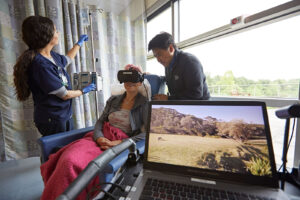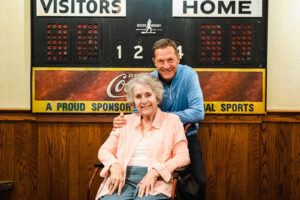Nausea, fatigue, pain, depression—these common side effects of cancer treatment are pesky at best and debilitating at worst. But what if you were able to sit in a room for 30 minutes once a week and have all of that pain subside through a noninvasive, drug-free way?
That’s what neurofeedback therapy attempts to do.
Neurofeedback, also known as neurotherapy or EEG biofeedback, is a therapeutic approach that “provides immediate feedback from a computer-based program” assessing a client’s brainwave activity, according to Psychology Today. Utilizing sound or visual signals, brain signals are reorganized and retrained in order to regulate brain function.
It may sound like science fiction, but neurofeedback has been around since the 1970s when it was first used to treat symptoms of ADHD like hyperactivity and inattention. While research on the practice related to cancer is limited, the studies that do exist have shown promising potential for warriors.
A 2019 study in the journal Integrative Cancer Therapies concluded that “there is initial evidence that NF is a complementary, drug-free and noninvasive therapy that has the potential to ameliorate symptoms [in cancer patients] such as pain, fatigue, depression and sleep.” Within one month, all participants in the group who received neurofeedback self-reported reduced pain.
The attractiveness of neurofeedback is hard to ignore. It’s non-invasive and serves as an appealing complementary approach to treatment among mile-long prescription lists and lengthy hospital stays. “[Neurofeedback] allows the brain to learn self-regulation skills and has influence on self-efficacy,” the study’s authors write. It is an especially alluring procedure for those who are body-oriented, and treatment success is quickly visible.
The procedure is also relatively easy to learn and portable biofeedback devices are growing in availability, leading to more expansive accessibility for warriors who may be interested in trying it out for symptom management.
Chicagoland-based Allen “Lucky” Gorman normally spends his week directing his restoration and remodeling business, but a few years ago he took on a different type of passionate project—offering LENS neurofeedback sessions through Chicago Brain Tech.
LENS builds upon the traditional aspects of neurofeedback in order to deliver what is deemed as more innovative, cutting-edge procedures. Rather than using images and sounds to recalibrate brain function, LENS opts for electromagnetic waves through scalp sensors attached to the client. It is much more passive for the client compared to traditional neurofeedback; you simply sit back and relax.
Gorman first became interested in neurofeedback through his weekly workout group. Over a matter of months, one of his buddies became focused, sharp and fast—mentally and physically. It turned out that he was undergoing regular neurofeedback sessions.
This impressed Gorman so much that he decided to see what neurofeedback was all about for himself. He sat for a couple of sessions and witnessed his response times improve, walking away pretty happy with the results. A few months later, he sought out neurofeedback again.
Chemo is effective, but it can go overboard, and this resolves many of the side effects for people. You can go back to work the next day.
“I was looking at the workload for my other business for the upcoming week, and I didn’t know how I was going to get through it,” says Gorman. “I stumbled through that week, and then decided, ‘OK, let’s try a session.’ I left that session, and everything was perfectly clear. A few months later, I found myself in the same situation and had the same result.”
For Gorman, it was imperative that he share this eye-opening experience with others. After undergoing training and becoming certified to offer sessions, he founded Chicago Brain Tech to help all kinds of clients—including cancer warriors.
“For people who have [recently undergone chemo], sessions are really quite simple,” he says. “[Neurofeedback] acts like a tuning fork and allows the brain to think, “Oh, this is where my balance is.” It’s a subtle neurotransmission, and the trick of the technology is sensing something so delicate.”
“We usually monitor anywhere between six and 23 sites on the brain, take a look at them and see how they read out on the screen, then focus on those hit hardest,” Gorman continues. “Chemo is effective, but it can go overboard, and this resolves many of the side effects for people. You can go back to work the next day.”
Neurofeedback is especially helpful in addressing chronic chemotherapy-induced peripheral neuropathy (CIPN), a 2016 study from The University of Texas MD Anderson Cancer Center found. A common side effect of chemotherapy, CIPN consists of symptoms like pain, burning, tingling and loss of feeling. In the study, 73 percent of participants who received neurofeedback reported improvement in their pain and quality of life.
This type of life-changing result from neurofeedback is the driving force behind Gorman’s practice.
“It helps and supports others,” he says. “It’s far more interesting, fascinating and engaging than the business I operated, so I put in the years of training required. It’s satisfying watching folks do better. Why do something else?”







